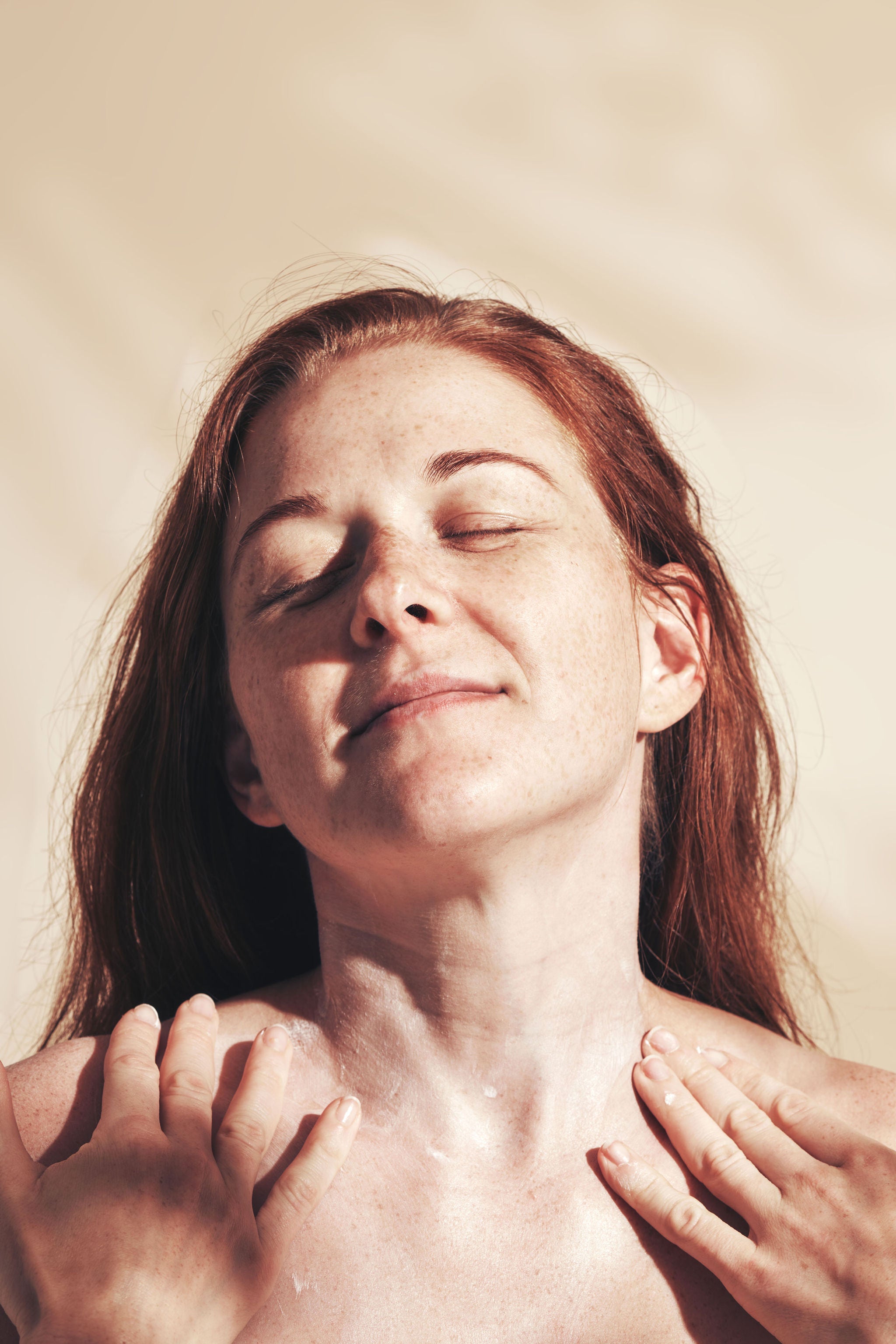Shea butter is an ancestral remedy from Central and West Africa. A skincare essential, it’s packed full of nutrients that hydrate, restore skin cells, relieve inflammation, and fight acne.
If you’re familiar with natural skincare trends, you know that the fewer ingredients, the better. But what if you could simplify your skincare routine even further and improve texture, tone, and vibrancy with just one ingredient?
Shea butter is that ingredient. Since it’s nutrient-dense and melts on contact with your skin, shea butter is a one-ingredient wonder that comes from ancestral communities in Africa.
The History of Shea Butter
Shea butter has a rich history as a natural skin remedy and cooking oil (specifically in West and Central Africa). Dating all the way back to ancient Egypt, it was used by Cleopatra as a beauty tool and moisturizer. Today, it’s a symbol of wealth and wellness in African culture. Although the influence of shea butter has spread across the globe, small markets in Nigeria and Ghana are still said to be the best place on earth to buy and experience shea butter.
Where Does Shea Butter Come From?
Shea butter comes from the nut of the shea tree, which grows in Central and West Africa. To extract shea butter the traditional way, the shea fruit is harvested and opened to reveal the shea seed. It then goes through a process where it’s washed, cracked, and roasted before being ground into a paste and mixed with water. The final step involves boiling the crushed shea until the fat rises to the top and is extracted. When finished, unrefined shea butter can range from colors of white and grey to golden.
As shea butter becomes more commercialized, manufacturers are using less traditional methods to extract it, including solvent extraction. This method tends to produce lower-quality shea butter and requires chemicals like hexane, benzene, or petroleum.
Nutrients in Shea Butter
Shea butter is packed full of nutrients and vitamins that support healthy skin and hair. It’s famous for its fatty acid content (oleic, stearic, palmitic, and linoleic), natural vitamin A (retinol), vitamin E, triglycerides, and anti-inflammatory properties.
What Does Shea Butter Do for Your Skin? The Benefits
We’re still discovering the benefits of shea butter. You should add shea butter to your skincare routine because it’s naturally anti-inflammatory, great for acne, boosts collagen production, and doesn’t clog pores. It’s also a well-loved remedy for stretch marks and eczema.
Anti-inflammatory properties
Shea butter is famous for bioactive triterpenes (plant compounds that are anti-inflammatory). These compounds can help soothe skin breakouts, redness, and eczema. They’re also skin regenerating, so they may boost collagen production and accelerate healing.
Boosts collagen production
The natural vitamin A and bioactive triterpenes found in shea butter both help increase collagen production in the skin. Collagen is a protein in your body that offers structure to your skin and connective tissues. In other words, it’s your skin’s natural way of fighting aging, scarring, and skin disruption.
Extremely moisturizing
There are three categories that describe skin moisturizers: emollient, humectant, and occlusive. Shea butter naturally falls into two of these categories, working as a natural emollient and humectant to moisturize the skin from multiple angles.
The humectant properties of shea butter draw moisture from the air and lock it into your skin barrier. The emollient properties soothe irritated or dry skin by using nutrients to fill the gaps between skin cells.
Creates a fatty acid barrier
Raw shea butter is full of fatty acids like oleic, stearic, palmitic, and linoleic acid. These moisturize the skin without clogging pores or disrupting your natural skin barrier. It can also reduce your skin’s contact with pollution and dirt.
Accelerates wound healing
Adding moisture and nutrients to a wound is one of the best ways to accelerate healing and reduce scarring. Shea butter accomplishes this with its emollient and humectant properties. It also exposes the wound to natural vitamin E and bioactive triterpenes, which are known to regenerate skin cells.
Good for eczema and psoriasis
A combination of anti-inflammatory properties, skin-soothing ingredients (like fatty acids), and skin-regenerating compounds, shea butter may be used for eczema, psoriasis, and other conditions.
Fights acne
Although shea butter is extremely thick, it’s noncomedogenic (meaning it doesn’t clog pores). People with acne find it helps soothe breakouts and restore the skin’s natural barrier and oil production.
May reduce signs of aging
Use shea butter as part of your skincare routine if you want a plant-based remedy that fights wrinkles, fine lines, and uneven skin tone. The natural vitamin E and fatty acids in shea butter work to restore skin cells while boosting natural collagen production.
Great for stretch marks
Shea butter has long been considered the best remedy for stretch mark prevention and treatment. You can use raw shea butter on your belly throughout pregnancy or find a cream that has shea butter as one of the first ingredients.
Doesn’t need any harsh chemicals to be effective
Many natural ingredients are mixed with oils or chemical compounds to improve their effectiveness or shelf life. Shea butter is one of the rare ingredients that doesn’t need any additives. It melts on contact with your skin and, although you can add ingredients to it, you don’t have to.
Naturally antifungal
Shea butter contains antifungal properties, making it a powerful natural remedy for athlete’s foot, ringworm, dandruff, and other fungal concerns.
Protects your skin in harsh environments
If you live in a dry, extremely cold, or heavily polluted environment, shea butter can protect your skin from the elements. Apply it before walking outside for a protective barrier of fatty acids.
How to Apply Shea Butter to Your Skin
It’s easy to melt raw shea butter directly onto your skin or make a lotion bar at home.
Melt it directly on your skin
Raw and unrefined shea butter melts at a temperature of 89 to 100 degrees Fahrenheit. Since this is so close to your body temperature, shea butter should melt on skin contact. This makes it extremely easy to use as a single-ingredient product (although you can mix it with other oils and butters for added benefits).
Make shea butter lotion bars at home
You can make your own shea butter lotion bars at home by melting down shea butter with other ingredients, like mango butter or cocoa butter. Consider adding beeswax, jojoba oil, raw honey, and essential oils (depending on your skincare needs). Once melted together, pour the mixture into soap molds and wait for it to harden.
Mix it with cocoa butter
If you don’t like the natural scent of shea butter, you can mix it with cocoa butter. This is another ancestral remedy from West Africa that melts on contact with your skin. You can either mix the two ingredients together by melting them in a boiler, or simply apply them to your skin at the same time. Cocoa butter has a pleasant chocolatey scent.
Apply after a shower
The best time to apply shea butter is after a shower. The humectant properties will draw even more moisture from the air into your skin, and the butter will melt and spread more easily if your body temperature is slightly elevated.
Shea Butter for Face vs. Shea Butter for Body
A little shea butter goes a long way. Since shea butter is rich and protective, apply it as the last step in your skincare or body moisturizing routine. You can apply the raw butter directly to your skin (it will melt on contact) or find a shea butter lotion.
Shea butter for face
It’s safe to apply shea butter directly to your face (although you should always test the product on a small area of skin first). Shea butter doesn’t make the best canvas for makeup, so it’s best to use during your nightly routine and after any serum or skincare. This will also give it the best opportunity to regenerate skin cells. You can rub the shea butter between your hands and apply it to your face. Or you can take a block of shea butter and apply it directly to your cheeks, nose, forehead, and chin. Always use shea butter that’s either 100% raw or mixed with natural ingredients.
Shea butter for body
It’s best to apply shea butter to your body after a shower. While your skin is still warm, use it like a lotion or body oil and spread it over your legs, arms, torso, and feet. A little goes a long way. You can use a block of raw shea butter or find a shea butter product that includes only natural ingredients.
How to Source High-Quality Shea Butter
The best shea butter comes straight from West and Central Africa, with no added ingredients or heavy processing.
Use raw and unrefined shea butter
A block of 100% raw and unrefined shea butter is perfectly acceptable for your skincare routine. It’s relatively inexpensive and won’t expose you to toxic and ineffective chemical ingredients. Plus, raw shea butter melts on contact with your skin and isn’t greasy.
Look for limited ingredients
Shea butter is a skincare powerhouse on its own. You don’t need chemical fillers, preservatives, or other additives to experience the benefits of shea butter. (In fact, these ingredients often take away from your results.) That said, some people don’t like the scent of shea butter or want to mix in other natural ingredients. You can try a premade shea butter lotion bar, infuse makeup products with shea butter, or find a hydrating salve with oil-based nutrients.
Real Shea Butter vs. Clever Marketing
We live in the era of clever marketing — where shea butter and other natural compounds are advertised proudly on the front of lotion bottles. But when we actually apply these products to dry, disrupted, or inflamed skin, we rarely notice any change.
This is because drugstore products are diluted with chemical fillers, fragrances, hormone disruptors, and preservatives — all designed to lower the cost of manufacturing. Natural remedies like shea butter are usually listed at the bottom of ingredient labels simply for marketing purposes. There’s often very little shea butter in the product, and it’s likely low quality and solvent extracted.
Let this be your sign to try the real thing: shea butter with minimal ingredients from a natural skincare brand you trust.
Experience Real Shea Butter

